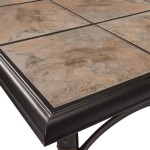Elevating Outdoor Spaces: A Comprehensive Guide to Patio Paint Ideas
The patio serves as an extension of the home, a transitional space that bridges the indoors and outdoors. Its design significantly impacts the overall aesthetic and usability of a property. A well-maintained and aesthetically pleasing patio can enhance curb appeal, increase property value, and provide a comfortable and inviting space for relaxation and entertainment. One of the most effective and affordable ways to transform a patio is through the application of paint. Selecting the right paint and color scheme can revitalize worn surfaces, protect against the elements, and create a personalized outdoor haven.
This article explores a range of outdoor patio paint ideas, providing insights into surface preparation, paint selection, color considerations, and creative techniques to inspire homeowners in creating their ideal outdoor living space. Understanding these principles is crucial for achieving a durable and visually appealing finish that withstands the rigors of outdoor exposure.
Surface Preparation: The Foundation for Lasting Results
Prior to applying any paint, thorough surface preparation is paramount. The longevity and appearance of the paint job depend heavily on the condition of the underlying surface. Neglecting this crucial step can lead to premature peeling, cracking, and fading, ultimately requiring more frequent repainting and additional expense. The specific preparation methods will vary depending on the type of patio material, such as concrete, wood, or brick.
For concrete patios, the process typically begins with a thorough cleaning to remove dirt, debris, mildew, and any existing loose paint. This can be achieved using a pressure washer or a scrub brush with a specialized concrete cleaner. Stubborn stains, such as oil or grease, may require targeted treatment with a degreasing agent. After cleaning, allow the concrete to dry completely before proceeding.
Next, inspect the concrete for cracks and imperfections. Small cracks can be filled with a concrete patch compound, while larger cracks may require more extensive repair. Ensure the patching material is compatible with the existing concrete and is applied according to the manufacturer's instructions. Allow the patch to cure completely before sanding it smooth to blend with the surrounding surface.
For previously painted concrete, it is essential to remove any loose or flaking paint. This can be accomplished using a scraper, wire brush, or sanding block. Feather the edges of the remaining paint to create a smooth transition. If the existing paint is in good condition, scuff sanding will help to create a better bond for the new paint layer. Prime the entire surface with a concrete primer designed to improve adhesion and provide a uniform base for the topcoat.
Wooden patios require a similar preparation process. Start by cleaning the wood with a deck cleaner to remove dirt, mildew, and loose debris. Inspect the wood for signs of rot or damage, and replace any compromised boards. Sand the surface to remove any splinters, rough spots, and existing paint or stain. If the wood is new, allow it to weather for several weeks before painting to allow the natural oils to dissipate.
For brick patios, cleaning is equally important. Use a pressure washer or a scrub brush with a brick cleaner to remove dirt, moss, and efflorescence (a white, powdery deposit that can form on brick surfaces). Repair any damaged or crumbling bricks with a brick mortar. If the brick has been previously painted, remove any loose paint using a wire brush or scraper. Apply a masonry primer to improve adhesion and prevent the paint from being absorbed into the porous brick.
Paint Selection: Choosing the Right Formula for Durability and Aesthetics
The choice of paint is critical for achieving a durable and aesthetically pleasing finish on an outdoor patio. Exterior paints are formulated to withstand the elements, including sunlight, rain, and temperature fluctuations. Selecting the appropriate paint type and finish will ensure the longevity and appearance of the paint job. Several factors should be considered when choosing paint, including the material of the patio surface, the desired level of durability, and the desired aesthetic.
For concrete patios, acrylic latex paints are a popular choice due to their durability, flexibility, and ease of application. Acrylic latex paints offer good resistance to cracking, peeling, and fading, and they are available in a wide range of colors and finishes. Consider using a paint specifically formulated for concrete surfaces, as these paints often contain additives that improve adhesion and resistance to moisture penetration. Epoxy paints are another option for concrete patios, offering superior durability and resistance to chemicals and abrasion. However, epoxy paints can be more difficult to apply and may require professional installation.
For wooden patios, exterior-grade acrylic latex paints are a good choice. These paints provide good adhesion to wood, resist cracking and peeling, and are available in a wide range of colors. Oil-based paints are another option for wood, offering excellent durability and a rich, lustrous finish. However, oil-based paints take longer to dry than acrylic latex paints and require mineral spirits for cleanup. Consider using a paint containing mildewcide to protect the wood from mildew growth.
For brick patios, masonry paints are specifically formulated to adhere to porous surfaces and resist moisture damage. These paints are typically made from acrylic latex or elastomeric polymers, which provide good flexibility and durability. Elastomeric paints are particularly well-suited for brick patios, as they can expand and contract with temperature changes, preventing cracking and peeling. Avoid using oil-based paints on brick, as they can trap moisture and lead to spalling (the chipping or crumbling of the brick surface).
In addition to the type of paint, the finish should also be considered. Matte finishes are ideal for hiding imperfections and creating a subtle, understated look. Satin finishes offer a slight sheen and are easier to clean than matte finishes. Semi-gloss finishes provide a more reflective surface and are even easier to clean, but they can also highlight imperfections. High-gloss finishes are the most durable and easiest to clean, but they can be too shiny for some applications. Consider the desired aesthetic and the level of maintenance required when choosing a paint finish.
Color Considerations and Creative Techniques: Transforming the Patio Aesthetic
The color palette chosen for a patio significantly influences the overall ambiance and aesthetic appeal of the outdoor space. Color psychology suggests that specific colors can evoke different emotions and create different atmospheres. Therefore, careful consideration should be given to selecting colors that complement the surrounding environment and enhance the desired mood.
Neutral colors, such as beige, gray, and white, are versatile choices for patios. These colors create a clean and modern look and can be easily paired with other colors in the outdoor space. Neutral colors also tend to reflect sunlight, helping to keep the patio cooler in hot weather. Lighter shades of gray and beige can make a small patio appear larger and more open.
Warm colors, such as red, orange, and yellow, can create a welcoming and inviting atmosphere. These colors can add vibrancy and energy to the patio space. However, warm colors can also be overwhelming if used in excess. Consider using warm colors as accents, such as on planters, cushions, or outdoor rugs.
Cool colors, such as blue, green, and purple, can create a calming and relaxing atmosphere. These colors are often associated with nature and can evoke feelings of peace and tranquility. Cool colors are particularly well-suited for patios that are used for relaxation and meditation. Lighter shades of blue and green can create a sense of spaciousness.
In addition to selecting a color scheme, consider incorporating creative painting techniques to add visual interest and personality to the patio. Stenciling is a simple and effective way to add patterns and designs to the patio surface. Use stencils to create geometric patterns, floral motifs, or personalized designs. Stenciling can be done with a variety of paint colors and can be applied to concrete, wood, or brick surfaces.
Another creative technique is to create a faux finish, such as a faux stone or faux brick pattern. Faux finishes can add texture and depth to the patio surface and can replicate the look of more expensive materials at a fraction of the cost. Faux finishes can be achieved using a variety of painting techniques, such as sponging, ragging, or stippling.
For concrete patios, consider using a concrete stain to add color and depth. Concrete stains penetrate the surface of the concrete, creating a durable and long-lasting finish. Concrete stains are available in a wide range of colors and can be used to create a variety of effects, such as a mottled or antiqued look.
Another option for concrete patios is to create a painted rug design. Use painter's tape to create the outline of a rug, and then fill in the design with paint. This can be a fun and creative way to add color and pattern to the patio surface. Consider using stencils to add intricate details to the painted rug design.
Ultimately, the best patio paint ideas are those that reflect the homeowner's personal style and preferences. By carefully considering the surface preparation, paint selection, color scheme, and creative techniques, homeowners can transform their patios into inviting and aesthetically pleasing outdoor living spaces.

12 Porch Patio Pool Deck Paint Color Ideas Beamin Moore
:max_bytes(150000):strip_icc()/faux-painted-rug2-5d0d2b1a8ddd4c60a39ffd329840874e.jpg?strip=all)
15 Painted Concrete Patio Designs

10 Painted Concrete Patio Floor Ideas So Much Better With Age

10 Painted Concrete Patio Floor Ideas Tiles Balcony Flooring
:max_bytes(150000):strip_icc()/HomeIdeologypatio-90780b59737a4935b1e853e2b397f3f1.jpg?strip=all)
15 Painted Concrete Patio Designs

16 Apartment Patio Ideas How To Decorate An Painted Flooring

10 Painted Concrete Patio Floor Ideas So Much Better With Age

The Solution To Decorating Concrete Patios Porches

Painted Concrete Patios Pros Cons How To Ideas Network

Concrete Patio Paint Ideas Domino








